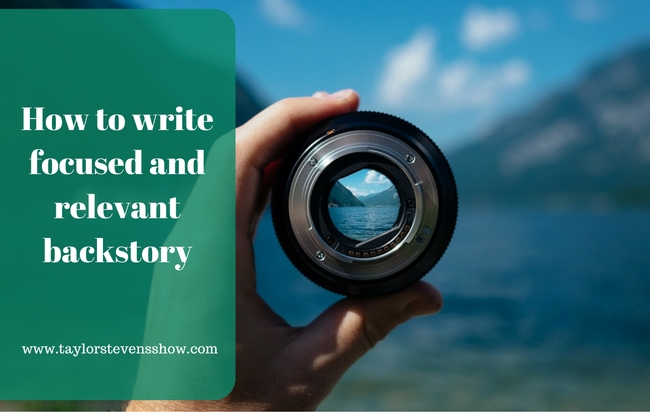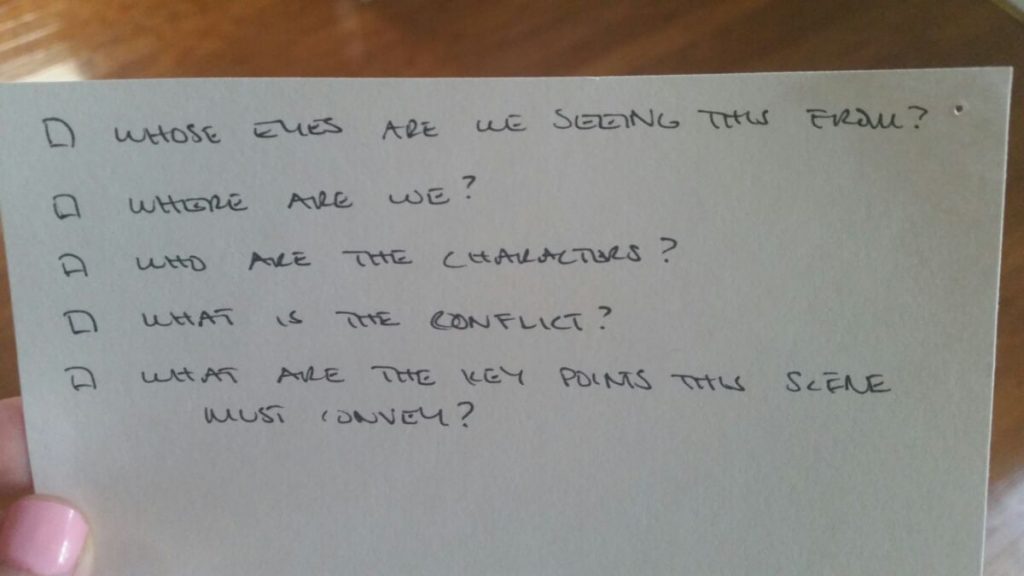
This week’s show is about writing backstory, both generally and for recurring series characters.
Podcast: Play in new window | Download
Subscribe: RSS
When you’re creating your characters, and you know they have this huge history just remember … all the reader really needs to know is what matters in the moment. — Taylor

Hi, Steve here! This week’s episode came out of a conversation that Taylor and I had following the recording of last week’s show. I made a comment, then Taylor starting teaching and then asked, “Hey, is the recorder running?” It wasn’t, but I turned it on, and she began again, which is where we pick up the teaching part of this show on writing backstory.
As Taylor explains during the show, it’s a balancing act the author must perform, giving first-time readers just enough information to understand the character’s motivation without annoying long-time readers who already know the character’s history.
Taylor explains the way she weaves backstory into her novels in small chunks, from the perspective of the character as a way of creating that all-important tension for the story. Then she shares the story of how her agent influenced the way she incorporates backstory in her novels now.
Taylor then shared that she keeps a notecard on her desk that she turns to when she’s mired in the muck of writing and isn’t clear on what the reader needs to see in a scene. Taylor holds the car up for us in the image to the left. The five things on the card are:

- Whose eyes are we seeing this from?
- Where are we?
- Who are the characters?
- What is the conflict?
- What are the key points this scene must convey?
All excellent points, and I’ve made a similar card for my writing desk!
 Since this week brings the start of the Summer Olympics, we open the show with a discussion of the Olympics and Taylor shares which Olympic sports she’d most like to be good at for both the Summer and Winter Olympics. Her choice for the Winter Olympics is figure skating, “of course” but for the Summer Olympics, she surprised me by choosing swimming or equestrian sports “that don’t involve broken bones.”
Since this week brings the start of the Summer Olympics, we open the show with a discussion of the Olympics and Taylor shares which Olympic sports she’d most like to be good at for both the Summer and Winter Olympics. Her choice for the Winter Olympics is figure skating, “of course” but for the Summer Olympics, she surprised me by choosing swimming or equestrian sports “that don’t involve broken bones.”
Thanks for Listening!
Thanks so much for joining us again this week.
If you have questions or suggestions for future shows, we’d love to hear from you. You can leave your suggestions as comments or find our contact information on the Connect page.
If you enjoyed this episode, please share it using the social media buttons you see on the left of the post.
Also, please leave an honest review for THE TAYLOR STEVENS SHOW Podcast on iTunes!
Ratings and reviews are extremely helpful and mean a great deal to us. They matter in the rankings of the show, and we read every one of them.
And finally, don’t forget to subscribe to the show on iTunes or Stitcher to get automatic updates.
Creative Commons Image via unsplash.
I haven’t even listened to this podcast yet and I’m laughing. Now that so many of us are using e-readers, it might make sense for us to tuck our backstory into an appendix at the back of the book, label it, “The Infodump Chapter” and call it a day.
LOL Bruce! First, Taylor gets full credit for the title, which is fantastic and I love your idea about the infodump chapter as an appendix in ebooks. I’d read it if I enjoyed the book. Heck, I actually read author notes, so the infodump chapter would be a nice plus 🙂 Sort of like the extras in a DVD.
I think the term Taylor was looking for is in medias res. In Latin, it means “into the middle of things.”
However, starting the book with an “action chapter” that essentially shows how the characters and the world works without having to info-dump has been called “the ice monster scene” by (if I’m remembering correctly) science-fiction author Michael Stackpole. He used it in a workshop he gave at Dragon*Con in Atlanta a few years back, referring to the opening scene of A Game of Thrones by George R. R. Martin, where he does exactly that. (I’ll see if I can dig up my notes to verify it was Mike.)
The first chapter of the novel I’m writing is exactly that — showing how the characters, the world, and my magic system all work by showing them in action.
Great stuff, Gary – thanks! I’m glad someone is better with Latin than we were in this episode. Love the term, “the ice monster scene.” I’m going to look up the original ice monster scene in Game of Thrones to see how GRRM did it back then.
Awesome, Gary! Thank you so much. I’m just shocked I got as close as I did… hee 🙂
fwiw … i (think i) remember stephen king writing about in media res vs “a-z” storytelling in his book On Writing. And that he was more of an a-z guy, because if you start in the middle, eventually you have to get back to the beginning, which can rather derail the train of the story. of course both can work, both have their place … thanks for the great show(s)!
Thanks for chiming in Karl! I tried to look it up on my Kindle version of On Writing, but I don’t have it on the Kindle, I have a paper copy, which isn’t nearly as searchable 🙂 That is a fantastic book for writers. Hmmm – I wonder if Taylor’s read On Writing?
I have, Steve 🙂 I was actually just discussing that book with someone the other day. It’s been years since I read it–before I got published–but I remember at the time being completely enthralled with the book (and adoring Stephen King in the process), and just recently thinking I really should go back and read it again.
How did I not see this comment until now? Thanks so much, Karl, for taking the time to stop by and visit with us 🙂 … both definitely have their place. My frame of reference is thrillers and in thrillers if you take too much time setting up the action, readers are not shy about letting you–and the rest of the world–know how boring you are.